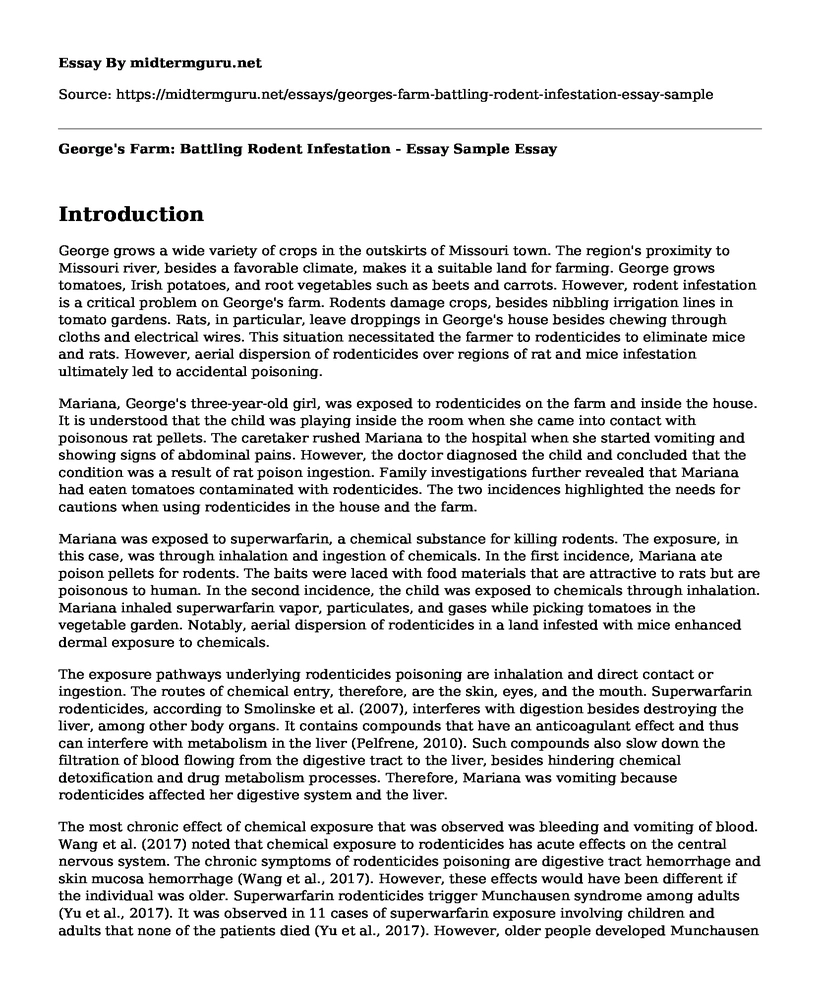Introduction
George grows a wide variety of crops in the outskirts of Missouri town. The region's proximity to Missouri river, besides a favorable climate, makes it a suitable land for farming. George grows tomatoes, Irish potatoes, and root vegetables such as beets and carrots. However, rodent infestation is a critical problem on George's farm. Rodents damage crops, besides nibbling irrigation lines in tomato gardens. Rats, in particular, leave droppings in George's house besides chewing through cloths and electrical wires. This situation necessitated the farmer to rodenticides to eliminate mice and rats. However, aerial dispersion of rodenticides over regions of rat and mice infestation ultimately led to accidental poisoning.
Mariana, George's three-year-old girl, was exposed to rodenticides on the farm and inside the house. It is understood that the child was playing inside the room when she came into contact with poisonous rat pellets. The caretaker rushed Mariana to the hospital when she started vomiting and showing signs of abdominal pains. However, the doctor diagnosed the child and concluded that the condition was a result of rat poison ingestion. Family investigations further revealed that Mariana had eaten tomatoes contaminated with rodenticides. The two incidences highlighted the needs for cautions when using rodenticides in the house and the farm.
Mariana was exposed to superwarfarin, a chemical substance for killing rodents. The exposure, in this case, was through inhalation and ingestion of chemicals. In the first incidence, Mariana ate poison pellets for rodents. The baits were laced with food materials that are attractive to rats but are poisonous to human. In the second incidence, the child was exposed to chemicals through inhalation. Mariana inhaled superwarfarin vapor, particulates, and gases while picking tomatoes in the vegetable garden. Notably, aerial dispersion of rodenticides in a land infested with mice enhanced dermal exposure to chemicals.
The exposure pathways underlying rodenticides poisoning are inhalation and direct contact or ingestion. The routes of chemical entry, therefore, are the skin, eyes, and the mouth. Superwarfarin rodenticides, according to Smolinske et al. (2007), interferes with digestion besides destroying the liver, among other body organs. It contains compounds that have an anticoagulant effect and thus can interfere with metabolism in the liver (Pelfrene, 2010). Such compounds also slow down the filtration of blood flowing from the digestive tract to the liver, besides hindering chemical detoxification and drug metabolism processes. Therefore, Mariana was vomiting because rodenticides affected her digestive system and the liver.
The most chronic effect of chemical exposure that was observed was bleeding and vomiting of blood. Wang et al. (2017) noted that chemical exposure to rodenticides has acute effects on the central nervous system. The chronic symptoms of rodenticides poisoning are digestive tract hemorrhage and skin mucosa hemorrhage (Wang et al., 2017). However, these effects would have been different if the individual was older. Superwarfarin rodenticides trigger Munchausen syndrome among adults (Yu et al., 2017). It was observed in 11 cases of superwarfarin exposure involving children and adults that none of the patients died (Yu et al., 2017). However, older people developed Munchausen syndrome, a health condition where an individual shows signs of mental illness (Yu et al., 2017). Chemical exposure in the case study could be avoided by placing rodenticide pellets in strategic points that are inaccessible to kids. Also, areas sprayed with such chemicals should be protected to prevent accidental ingestion.
Conclusion
In conclusion, the ingestion of rodenticides has adverse health effects on adults and children. Its main exposure pathways are direct contact and inhalation. These chemicals adversely affect metabolism and chemical detoxification processes in the liver. Exposure to rodenticides can be avoided by placing rat pellets in areas where children cannot easily access.
References
Pelfrene, A. F. (2010). Rodenticides. In Hayes' Handbook of Pesticide Toxicology (pp. 2153- 2217). Academic Press.
Smolinske, S. C., Scherger, D. L., Kearns, P. S., Wruk, K. M., Kulig, K. W., & Rumack, B. H. (2007). Superwarfarin poisoning in children: a prospective study. Pediatrics, 84(3), 490-494. DOI: 10.1016/s0196-0644(05)82074-8
Wang, M., Yang, Y., Hou, Y., Ma, W., Jia, R., & Chen, J. (2017). Effects of bromadiolone poisoning on the central nervous system. Neuropsychiatric Disease and Treatment, Volume 13, 2297-2300. DOI: 10.2147/ndt.s142375
Yu, H., Lin, J., Fu, J., Lin, J., Liu, S., Weng, C., Yen, T. (2013). Outcomes of patients with rodenticide poisoning at a Far East poison center. Springer Plus, 2(1), 505. DOI: 10.1186/2193-1801-2-505
Cite this page
George's Farm: Battling Rodent Infestation - Essay Sample. (2023, Feb 07). Retrieved from https://midtermguru.com/essays/georges-farm-battling-rodent-infestation-essay-sample
If you are the original author of this essay and no longer wish to have it published on the midtermguru.com website, please click below to request its removal:
- Membrane Ultrafiltration: Preliminary Treatment of Wastewater
- Discussion Questions on Environmental Governance - Paper Example
- The Chimpanzee Diet Diary Paper Example
- Essay Sample on Business Resiliency: Hurricane Sandy
- Exploring the Frontier: A Deeper Understanding of the Wild West - Essay Sample
- Power Plant Developments in US - Impacts on Society & Environment - Essay Sample
- Nature: Our Lifeline That Needs Preserving - Essay Sample







